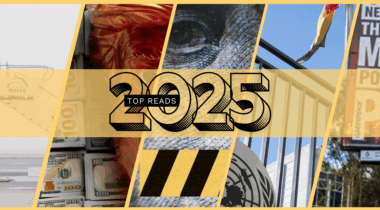Tim Butler ■ Illicit Capital Flows and the Offshore Economy

For a general “Magnitudes” page giving estimates of the size of illicit financial flows and other measurements that are of interest to TJN, click here.
< Update: March 2009. Christian Aid’s False Profits: robbing the poor to keep the rich tax-free estimates that between 2005 and 2007, the total amount of capital flow from bilateral trade mispricing into the EU and the US alone from non-EU countries is estimated conservatively at more than US$1.1tn (£581.4bn, €850.1bn) >
< Update: March 2009. Oxfam estimates that developing countries miss out on up to $124 billion every year in lost income from offshore assets held in tax havens. >
< Invitation to participate in a workshop on Erosion of Public Finances in Developing Countries: Illicit Flows and Commercial Corruption, National Autonomous University of Mexico, September 2009 >
Capital Flight
Capital flight is notoriously hard to define precisely. Many people agree that it involves the deliberate and illicit disguised expatriation of money by those resident or taxable within the country of origin. According to a 2005 book on the subject, capital flight generally means “an outflow of capital that is not part of normal commercial transactions from a country where capital is relatively scarce.” As a result of capital flight, domestic resources available for development and for financing public services are reduced. Capital flight also depresses economic activity and has a negative impact on long-term growth rates.
Tax evasion is often the motive for the flight of capital and the two are implicitly linked. But other reasons exist too — such as seeking a secure location for cash resources, avoiding local currency risk, or avoiding other legal obligations within the state from which capital flight takes place. (These might, for example, relate to inheritance laws.) For these reasons, capital flight would remain a problem even if there were no tax incentive implicit within it.
What is certain, however, is that capital flight impacts negatively on capital-scarce economies: the loss of domestic savings leads to lower levels of internally funded investment, and the loss of tax revenues flowing from those savings leads to lower revenues available for public spending on health, education and public infrastructure. Additionally, use of external borrowings to finance government deficits imposes a debt servicing burden which impacts heavily on economic growth and social stability and attractiveness to investors. It is also important to remember that the tax loss from capital flight is likely to be greater than that from domestic tax evasion of initially similar value. This is because in the case of domestic tax evasion the money stays in the country and generates at least some tax revenue (for example sales tax or VAT when it is spent in the local economy) whereas capital that has fled offshore is not invested locally and does not generate local tax revenue.
Capital flight has certain characteristics that help distinguish it from normal monetary and resource flows. These are:
- Flight capital is domestic wealth permanently put beyond the reach of appropriate domestic authorities. Much of it is unrecorded due to deliberate misreporting;
- Because no (or little) tax is paid on wealth that is transferred as capital flight, it is associated with a public loss and private gain.
- Because tax evasion is illegal and subject to criminal sanction in most countries, the management of flight capital is a form of money laundering. Offshore secrecy arrangements play a crucial part in the laundering process by enabling the origin and ownership of the capital to be effectively disguised.
It must be stressed that legal, well-documented and reported flows of wealth on which proper taxes have been paid are a perfectly legitimate part of everyday commercial transactions and do not constitute capital flight. Legal international payments include those where:
- The source of the wealth being transferred abroad is legal;
- The outflows represent fair payment in a commercial transaction;
- The transfer of wealth does not violate any laws of the country relating to foreign exchange or capital control;
- The taxes due on the capital being transferred have been paid in the country of their origin;
- The flows constitute a part of the official statistics of the country involved and are properly reported, documented and recorded
While capital flight often occurs through similar channels to those used for the legitimate transfer of funds, it does not meet some (or all) of the characteristics listed above. Much of the capital flight that occurs in West Africa, for example, involves cash and other portable valuables, including gemstones and high value metals, being smuggled across national boundaries. Trade mis-pricing is an alternative way of shifting capital across national boundaries, particularly when large sums are involved. Trade mis-pricing can be conducted in a number of ways, including mis-invoicing, transfer mis-pricing, re-invoicing through an apparently unrelated trading partner in an offshore territory, and other fraudulent invoicing practices. Abnormally high priced import transactions are used to reduce the taxable profits in the country of import. They can also facilitate money laundering and can be used to disguise illegal commissions hidden in the inflated prices. Investigation of these types of fraudulent activities is made significantly more difficult by the opaque offshore structures used to disguise the identities of the different parties to the transactions.
A 2005 book contains some interesting history:
“The neglect of capital flight in current debates is striking given the attention it received at the 1944 Bretton Woods conference, (which) is said to have laid the foundations for today’s financial order and many reformers today talk of the need for a ‘renewed Bretton Woods vision’ The Bretton Woods architects saw the regulation of capital flight as a key pillar of the international financial order they hoped to construct.”
The two principal Bretton Woods architects, Harry Dexter White and John Maynard Keynes, were principally worried about large-scale capital flight from war-devastated European countries to the US, destabilising them and turning some of them towards the Soviet bloc. They recognised the difficulties in exerting capital controls, and they addressed these with a further proposal, as the book explains:
“They argued that controls on capital would be much more effective if the countries receiving that flight capital assisted in their enforcement. In their initial drafts of the Bretton Woods agreement, both Keynes and White required the governments of receiving countries to share information with the governments of countries using capital controls about foreign holdings of the latter’s citizens. White went further in his draft to suggest also that receiving countries should refuse to accept capital flight altogether without the agreement of the sending country’s government. Both of these proposals were strongly opposed by the U.S. financial community which had profited from the handling of flight capital in the 1930s . . . in the face of this opposition, the final IMF Articles of Agreement contained watered-down versions of Keynes’ and White’s roposals. Co-operation between countries to control capital movements was now merely permitted, rather than required.”
The replacement of one word with another has had nothing less than catastrophic consequences for the world’s poor.
Further reading
< Tax and Financing for Development, SOMO, October 2008. >
In April 2006 TJN’s John Christensen made a presentation to the United Nations called Why Capital Flight? How Plugging the Leaks could Contribute to Poverty Alleviation. As he argued, “The missing piece of the development equation is the impact of illicit capital flight and the associated tax evasion on global poverty.” See also a 2008 comment piece in the Financial Times by TJN’s John Christensen and David Spencer urging the world to push towards automatic exchange of tax information on a multilateral basis, as a key weapon in the fight against harmful capital flight.
Take a look at this conference speech (or see this pdf version) by Raymond Baker in June 2007, which gives an idea of the scale of the problem of capital flight from poor countries, and the role of the offshore world in promoting it. His book, Capitalism’s Achilles Heel, is a seminal work in this field, and was described by the economist Paul Collier as “the most careful and ingenious study to date”. We would also highlight the 2005 book Capital Flight And Capital Controls In Developing Countries.
We would also highlight research published in April 2008 by Léonce Ndikumana and James Boyce of the University of Massachusets, Amherst (see here), which studied 40 African countries, and states:
“Real capital flight over the 35-year period amounted to about $420 billion (in 2004 dollars) for the 40 countries as a whole. Including imputed interest earnings, the accumulated stock of capital flight was about $607 billion as of end-2004. . . . Over the past decades, African countries have been forced by external debt burdens to undertake painful economic adjustments while devoting scarce foreign exchange to debt-service payments. On the other hand, African countries have experienced massive outflows of private capital towards Western financial centers. Indeed, these private assets surpass the continent’s foreign liabilities, ironically making sub-Saharan Africa a “net creditor” to the rest of the world. . . The subcontinent’s private external assets belong to a narrow, relatively wealthy stratum of its population, while public external debts are borne by the people through their governments.”
The researchers were quoted on Reuters as callling capital flight “the single biggest threat to the continent’s developmental goals.
More information is also available on our website under this section on foreign aid and finance for development.
< Jan 2009: Global Financial Integrity report on illicit financial flows from developing countries. >
< Nov 2008: Christian Aid report on The impact of the financial crisis on the developing world >
Related articles

The tax justice stories that defined 2025

Let’s make Elon Musk the world’s richest man this Christmas!

2025: The year tax justice became part of the world’s problem-solving infrastructure

Bled dry: The gendered impact of tax abuse, illicit financial flows and debt in Africa
Bled Dry: How tax abuse, illicit financial flows and debt affect women and girls in Africa
9 December 2025

The myth-buster’s guide to the “millionaire exodus” scare story

Money can’t buy health, but taxes can improve healthcare
The elephant in the room of business & human rights
UN submission: Tax justice and the financing of children’s right to education
14 July 2025

